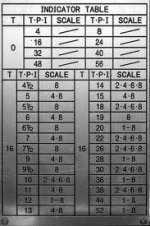I want a healthy discount!! LOL!!!
I was talking with a good friend of mine today and he was telling me that PT&G has breach cone cutting tools. This sounds really appealing to me. He says they are good tools especially for a beginner like myself. he single points everything now so he may sell them to me. i was just curious if anyone here uses these tools? I am going to build a cylinder type tool with a dial gauge .001 in the top with a spring and a cone slug inside so i can take readings from barrels i already have, and i can use this tool to check the cone on the barrel thats in the lathe. I think this will be a good way to duplicate the cone cut from one barrel to the next?
I still haven't decided on a tool for cutting crowns yet. To be boldly honest when i look on a web site or in the catalog i dont always know what i am looking at yet. I read a lot though and i am slowly educating myself. I will get there! Thanks guys. Lee
I was talking with a good friend of mine today and he was telling me that PT&G has breach cone cutting tools. This sounds really appealing to me. He says they are good tools especially for a beginner like myself. he single points everything now so he may sell them to me. i was just curious if anyone here uses these tools? I am going to build a cylinder type tool with a dial gauge .001 in the top with a spring and a cone slug inside so i can take readings from barrels i already have, and i can use this tool to check the cone on the barrel thats in the lathe. I think this will be a good way to duplicate the cone cut from one barrel to the next?
I still haven't decided on a tool for cutting crowns yet. To be boldly honest when i look on a web site or in the catalog i dont always know what i am looking at yet. I read a lot though and i am slowly educating myself. I will get there! Thanks guys. Lee






